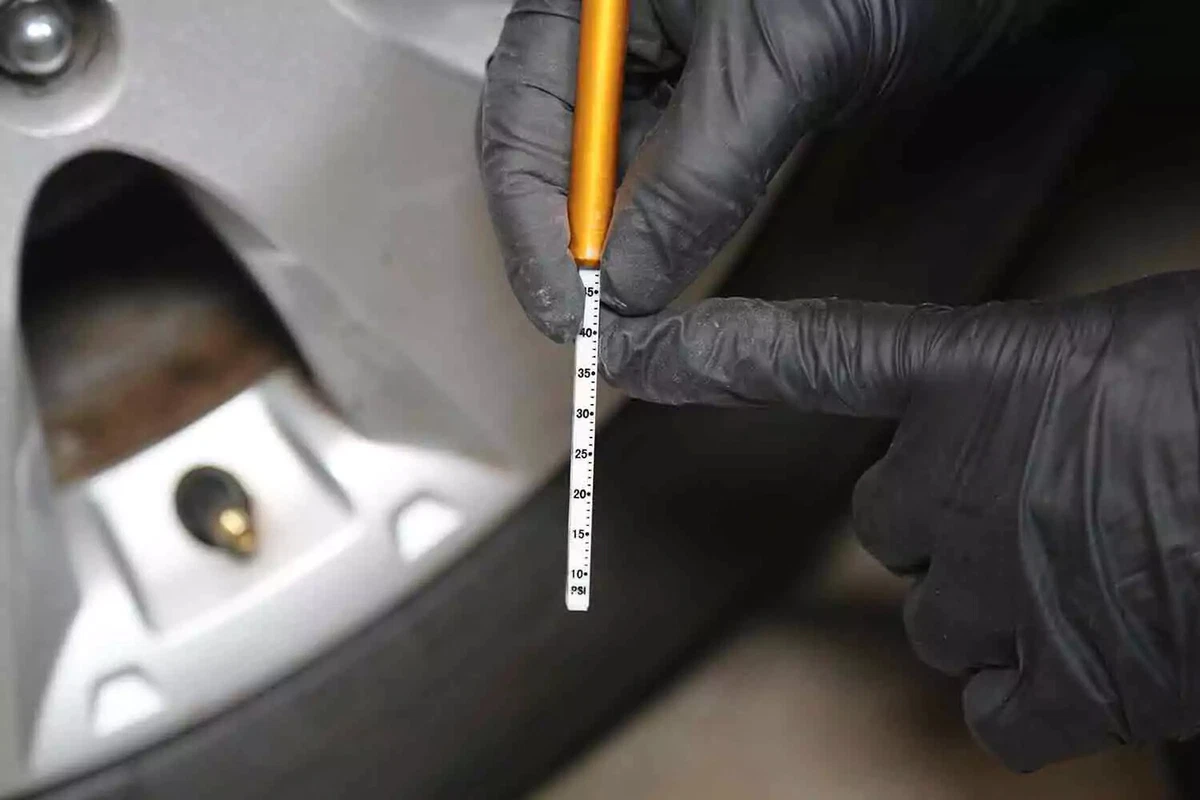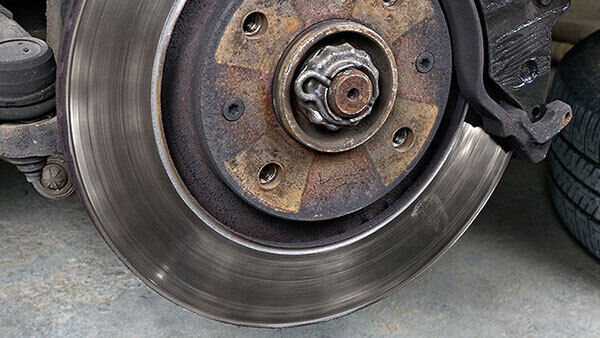Maintaining your tires is critical for safety. It doesn’t take much pressure loss to cause irreparable tire damage. Regularly check the air pressure for all your tires, including the spare.
Verify the recommended air pressure for your tires. Unless you’ve changed to a different size or type of tire on your vehicle, the best place to start is the sticker on the door frame. Also, check the maximum air pressure printed on the tire sidewall. Remember, that’s the maximum pressure. The correct pressure is probably lower.
You should check air pressure when the tires are cold. Air expands when heated, so the pressure will naturally go up after a few miles of driving. The recommended pressure listed on the tire is the cold pressure. If you must check tires when they are hot, you might need to add air when the tires cool down.
Low pressures will accelerate tire wear and adversely affect handling. Wet grip, in particular, is sensitive to having enough air in the tire to prevent hydroplaning. Excess pressure lowers cornering and braking grip by reducing the contact patch.
Tips & Tricks About Tire Pressure
-
Tire pressures change throughout the air when temperatures go up and down. Add more in the winter, and reduce the air pressure in the summer.
-
Many newer vehicles have tire pressure monitoring systems (TPMS). These sensors can fail, so you should also manually check your tire pressure. Tires without TPMS sensors should be checked with every fill-up.
-
One of the biggest causes of low tire pressure is neglecting to use a valve stem cap. The cap is the primary seal for the tire—not the valve stem’s small core, which is prone to leaks. Replace missing valve stem caps as soon as possible.
Advice for Changing a Tire
-
Passenger cars and crossover vehicles usually have a space-saver or “donut” tire in the trunk or cargo area. These smaller tires fit the vehicle but are narrower than the standard wheels. These emergency-only tires should be driven below about 55 mph and not more than 100 miles.
-
Donut spares typically call for pressures from 60 to 80 psi. The pressure level will be noted on the rim.
-
Trucks and full-size SUVs typically have a full-size spare mounted in the bed or under the vehicle. Use the jack handle to remove the tire from a cable mount. Check your owner’s manual for details.
-
Many high-performance vehicles have run-flat tires instead of spares. They might come with an air compressor and a tire sealant.
-
The factory-supplied jack is usually located near the spare tire. This is for emergency use only. We recommend carrying a small portable floor jack for emergencies. They are safer and easier to use.

Remove the cap from the valve stem. The cap is the primary seal. If it’s missing on any of your tires, replace it immediately.

Press the end of a tire pressure gauge firmly over the valve stem while holding the gauge head square to the valve stem. You might hear some air hissing, but the sound should stop before taking the reading.
If the air is hissing, you do not have the gauge on the valve stem correctly, and it will yield a false reading.

We used a manual gauge, which has a white stick that pops out of the gauge body. The pressure is the last visible number at the end of the gauge. The tire pressure shown here is about 48 psi. Each hash mark is one psi. Digital gauges provide a numeric pressure readout.

Measuring tire pressure and putting air in your tires is a good opportunity to inspect your tires’ condition. We discovered that one of the tires on the vehicle had a large bulge, indicating a broken belt inside the tire. This condition creates a major risk of a dangerous blowout. The tire is also bald, so it needs to be replaced.

The spare tire is typically under the trunk or hatch floor. For trucks, it is commonly under the vehicle body. For our car, the jack was in a container in the center of the spare.
Remove the tools and the spare.

Before you raise the vehicle, loosen the lug nuts. If you jack up the vehicle before loosening the lug nuts, the tire could spin.
Loosen the lug nuts until they break free, but don’t remove them yet.

It is common for lugs to be over-torqued. As a result, it can be difficult to break the lug nut free with a small tire iron. If necessary, set the tire iron on the lug, carefully stabilize yourself, and use your foot to break it loose.
Remember this rule: righty-tighty, lefty-loosey. Most vehicles built after 1963 have right-hand threads on all wheels, so turn the tire iron counter-clockwise.
For greater leverage, carry a plug-in impact gun or “cheater” pipe that slips over the end of the tire iron.

The factory-supplied emergency jack must use the vehicle’s designated jacking points. Find the two notches just behind the front wheels and just in front of the rear wheels. The factory jack has a notch that slides over the center between the body notches.
Some vehicles have a flat pad instead of notches. This location will likely have a sticker or other indication of the jacking point. If you can’t locate the jacking points, check your owner’s manual for the exact location. Jacking the vehicle at any other spot could damage the vehicle body.
Do not jack your vehicle if it’s parked on an incline. Regardless, set your parking brake and make sure the engine is off and the transmission is in Park (for automatics) or first gear (for manuals).
This will not prevent the vehicle from rolling off the jack if you’re jacking the drive wheels. If possible, use wheel chocks on the other two wheels.

With the jack in place, turn the handle to raise the jack until it elevates over the jacking point. Continue to raise the vehicle until the tire is off the ground.
Raise the vehicle high enough to get the replacement tire on the car.

The emergency jack for older vehicles might have missing components. Our jack was missing its handle. The tire iron was too large, so we improvised with a screwdriver.
The best remedy is to keep a high-quality portable floor jack in your vehicle for emergencies.

After the wheel is adequately off the ground, use the tire iron to remove the lug nuts. Set the removed lug nuts in a safe place. Then, remove the wheel from the vehicle.

Roll the spare into position. Lift it up to the wheel hub. You may need to raise the jack further.

Thread all the lug nuts on the spare tire by hand. If you install the lowest nut (closest to the ground) first, the wheel will be less likely to flop around, making it easier to install the others.
Tighten the lug nuts as much as you can while the wheel is in the air before lowering the vehicle. This will seat the wheel and center it on the hub.
Tighten the lugs in a criss-cross pattern.

Lower the jack until the tire touches the ground and doesn’t spin when you tighten the lug nuts.
Use all of your available force to tighten the lug nuts. Use your foot as illustrated in Step 7.
Unfortunately, our spare tire was flat. To avoid this problem, regularly check your spare tire’s air pressure, especially before a road trip.

Our spare tire’s pressure was 15 psi. The label on the wheel recommends 60 psi. We inflated the air on the spare (and all tires) to the recommended pressure.
When airing up a tire, you should not hear hissing from the valve stem, only the sound of air filling the tire. Press the air chuck firmly against the valve stem and adjust the position of the chuck until it stops hissing. Add air to reach the recommended tire pressure.
We recommend keeping a 12-volt air compressor in your roadside emergency kit for such occasions.

Return the jack components to their storage location. Then, put the flat tire in the trunk or cargo area.
Full-size wheels and tires usually don’t fit in the spare tire well. Trucks and large SUVs have full-size spares, so your original may fit in the spare tire location. If you choose to toss the flat in the bed or cargo area, wind up the spare tire cable. Leaving the cable loose while driving could damage the mechanism.
Share your feedback
This article is meant to provide general guidance only. Automotive maintenance, repair, upgrade, and installation may depend on vehicle-specifics such as make and model. Always consult your owner's manual, repair guide for specific information for your particular vehicle and consider a licensed auto-care professional's help as well, particularly for advance repairs.







































